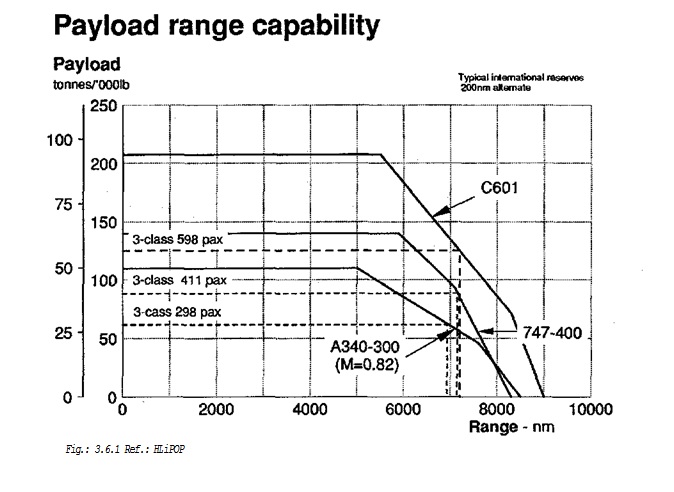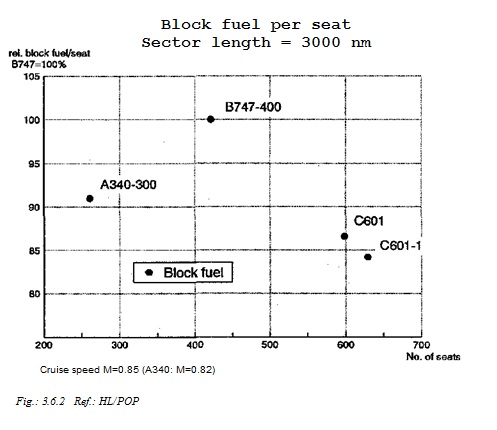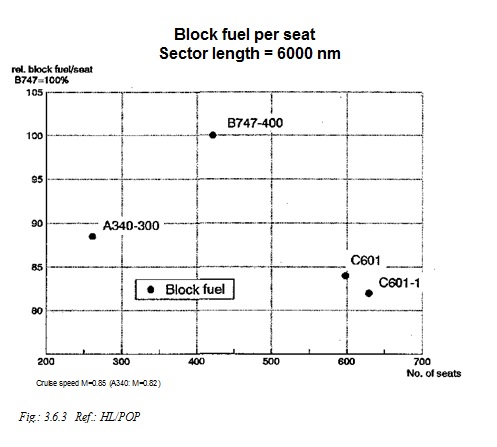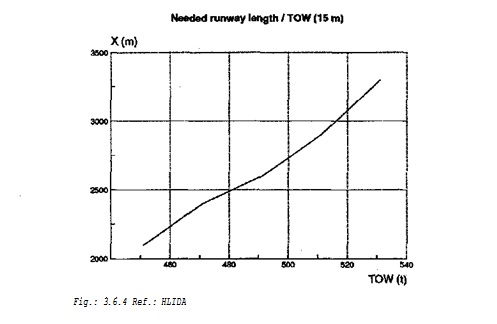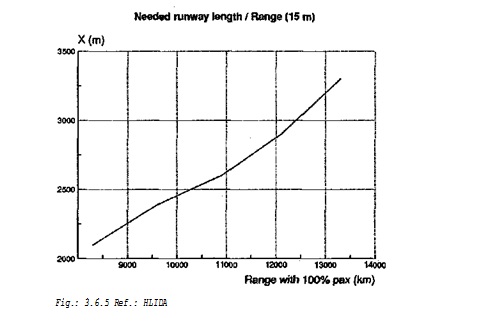3.6 AIRCRAFT PERFORMANCE
The determination of performance was made with the “Parametric Optimisation Program” (POP) of Airbus. This program simulates a flight, with the aerodynamic and engine data field, the Operational Empty Weight (OEW) and the Maximum Take Off Weight (MTOW). The start and landing phases are taken globally, the climb, cruise and descent phases are taken in many intervals. For reserves, typical international reserves are taken. The cruise is stepped in 1200 m intervals. The intervals changed when:
- the fuel consumption improved
- the 1.3 g buffet limit was not exceeded
- the maximum climb speed of 1.5 m/s was possible and
- the maximum cruise thrust was given.
The climb phase was taken with a Mach number of Ma = 0.8, the horizontal cruise speed was taken with Ma = 0.85. One of the compared aircraft, the A340 cruises with Ma = 0.82.
To compare the DOC and IOC of the UHCA with the A340, comfort had to be adapted to today’s standards. For a better comparison, the C601 was taken with a lower standard offering 629 seats. That is 105% of the seat capacity at 777 standard.
3.6.1 Payload to range
To see the high range and capacity of the UHCA the payload to range diagram is shown and to compare it the diagram of the A340-300 and the B747-400 are also plotted. A mission is shown, where no reserves are used (data see appendix III.6.1).
Fig.: 3.6.1 Ref.: HL/POP
All the aircraft have a similar design range and the payload is nearly proportional to the seat capacity. The long range of the UHCA is particular even with empty middle tanks (227 800 kg fuel in wing tanks is sufficient for 9000 nm and reserves).
3.6.2 Mission
An analysis of all airline flight plans by Airbus Industrie has shown that most aircraft designed for very long range (7000 nm) are mainly used over a range of about 3000 nm.
On the one hand the airlines demand an aircraft for very long ranges and on the other hand they want good economical data for an distance of 3000 nm.
The calculations were made with POP at DA for missions of 3000 nm and 6000 nm to see the trend. The block fuel per seat is of special concern for the comparison.
Block fuel per seat Sector length = 3000 nm
Fig.: 3.6.2 Ref.: HL/POP
Block fuel per seat Sector length = 6000 nm
Fig.: 3.6.3 Ref.: HL/POP
For the comparison, all seats were filled, there was no extra payload and all aircraft were flying at a speed of Ma=0.85, except the A340. The A340 had a speed of Ma=0.82, so its block times were 4% higher.
The comfort adapted versions of the UHCA has, compared to the B747, a 16% lower fuel consumption per seat over a distance of 3000 nm.
Over a distance of 6000 nm the fuel consumption per seat is 18% lower. Also the A340 is 9% at 3000 nm and 11% at 6000 nm lower in fuel consumption per seat than the B747.
Some advantages are achieved through benefits from new material, aerodynamic and engine technology. The aircraft size effect is small compared with them (see appendix II.6.1).
Take off weight
The take off length has to fit in the FAR 25 requirement. It is calculated with the “STAS” program of the Fachhochschule Hamburg. The reserves for aborted take off and an continued take off with a engine failure. Normally the take off distance is 90% of the on shown in the Figures 3.6.4/5.
The upper diagram shows the needed runway length depending on the take off mass were in the lower diagram the take off weight was related to a possible range at 100% seat capacity. Most missions can be started from much smaller runways than 3500 m.
Fig.: 3.6.4 Ref.: HLIDA
Fig.: 3.6.5 Ref.: HLIDA
The landing distance is assumed to be 1800 m and not critical.
